Human Resource Equity Analysis: Gender and Ethnicity Analysis Report
VerifiedAdded on 2022/10/02
|8
|2392
|262
Report
AI Summary
This report, titled "Human Resource Equity Analysis 2", examines the critical issues of gender and ethnicity equity within the workplace, drawing upon secondary data and both qualitative and quantitative research methodologies. The study delves into the impact of inattentional blindness and legal mandates on gender inequality, highlighting disparities in employment, perception, and employee retention, as well as the underutilization of female employees in leadership positions. The report also explores the effects of ethnicity on workplace equity, particularly for migrant employees, addressing challenges such as structural inequalities, lack of recognition, and wage gaps. Furthermore, the analysis links these issues to Adam's Equity Theory, providing a framework for understanding how perceptions of fairness influence employee motivation and behavior. It also examines the impact of diversity, the challenges of managing ethnically diverse teams, and the importance of training in fostering a more equitable and innovative work environment. The report's conclusion emphasizes the need for business administrative bodies to actively mitigate these inequities to improve workplace efficiency and employee engagement.
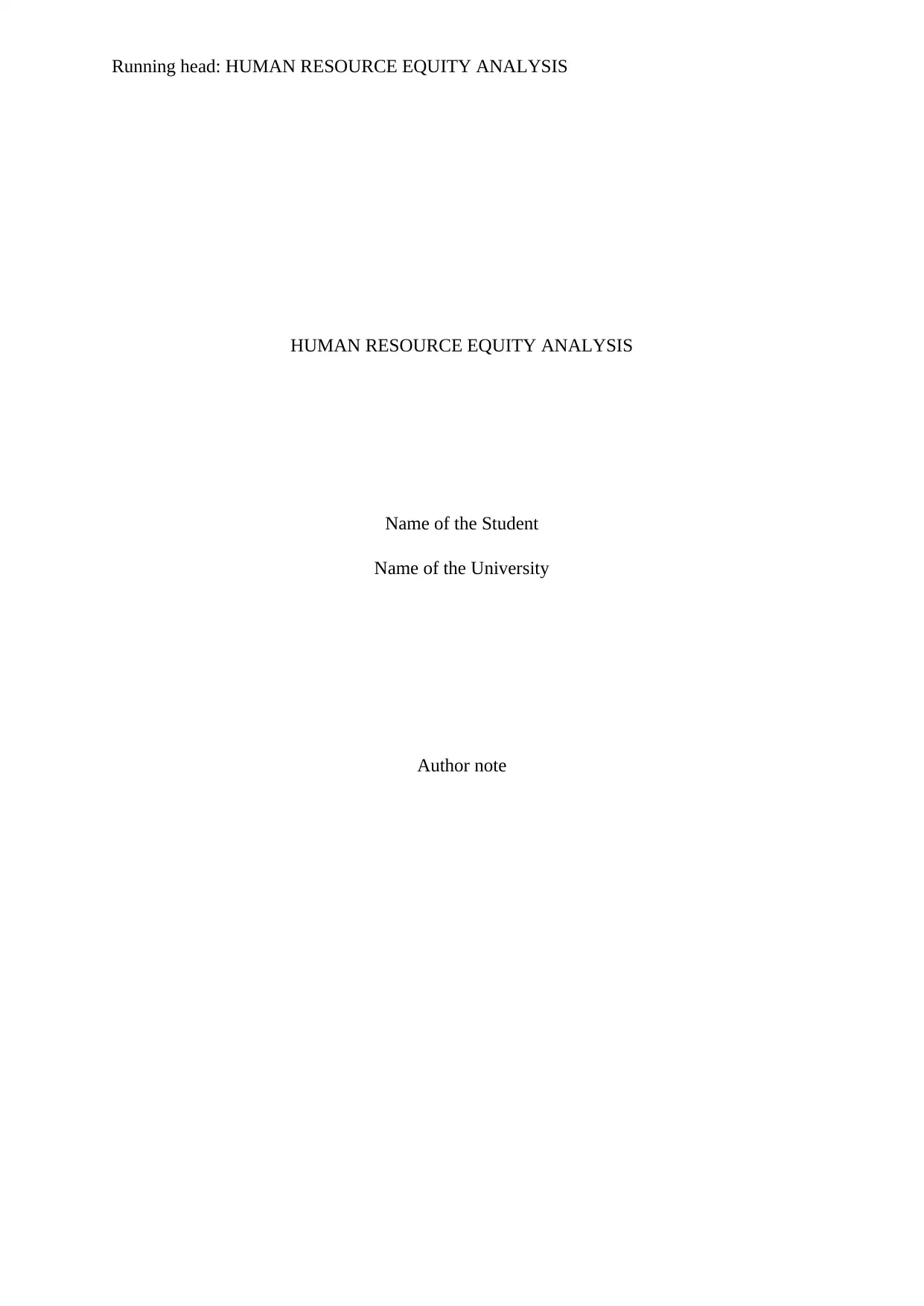
Running head: HUMAN RESOURCE EQUITY ANALYSIS
HUMAN RESOURCE EQUITY ANALYSIS
Name of the Student
Name of the University
Author note
HUMAN RESOURCE EQUITY ANALYSIS
Name of the Student
Name of the University
Author note
Secure Best Marks with AI Grader
Need help grading? Try our AI Grader for instant feedback on your assignments.
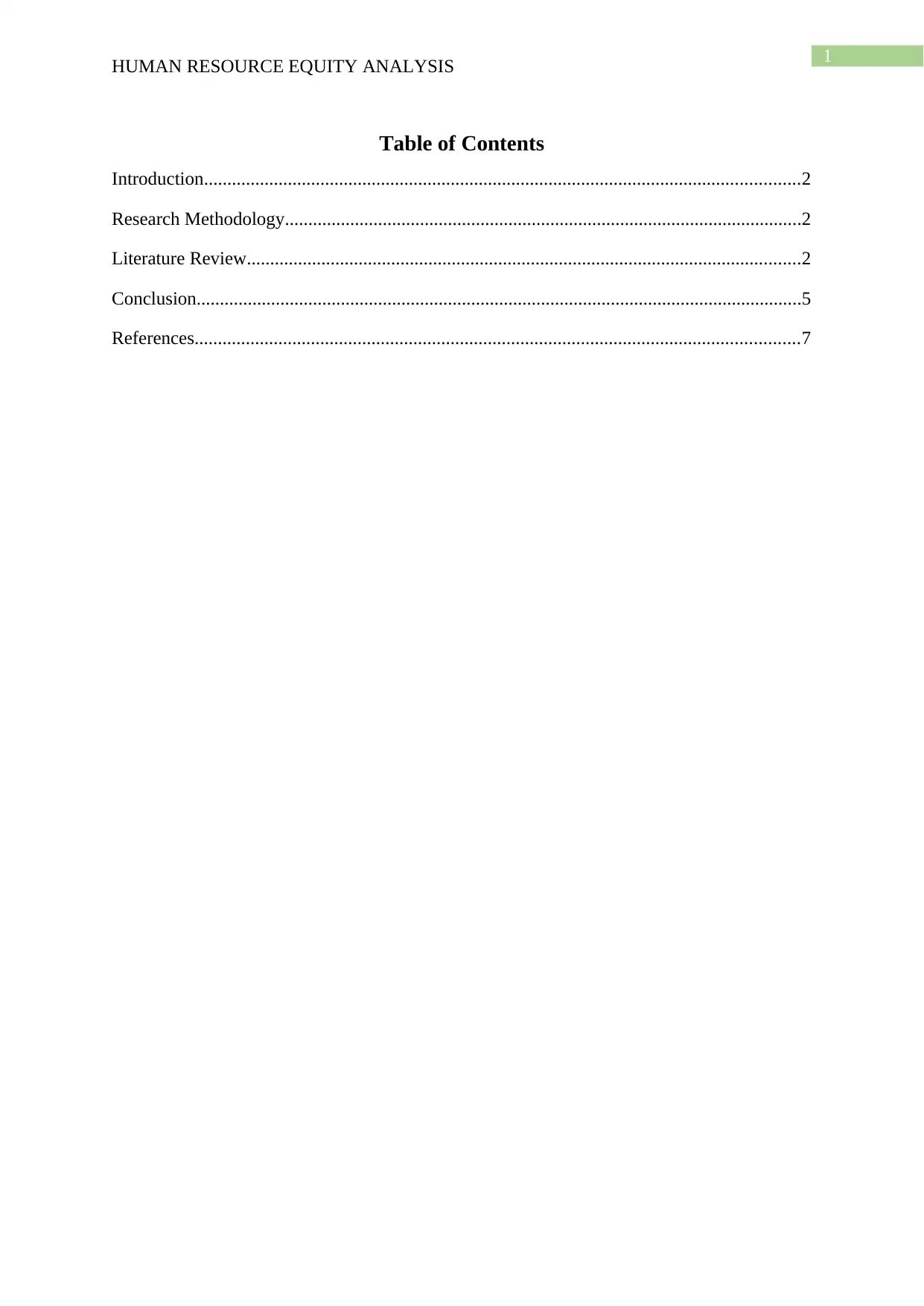
1
HUMAN RESOURCE EQUITY ANALYSIS
Table of Contents
Introduction................................................................................................................................2
Research Methodology...............................................................................................................2
Literature Review.......................................................................................................................2
Conclusion..................................................................................................................................5
References..................................................................................................................................7
HUMAN RESOURCE EQUITY ANALYSIS
Table of Contents
Introduction................................................................................................................................2
Research Methodology...............................................................................................................2
Literature Review.......................................................................................................................2
Conclusion..................................................................................................................................5
References..................................................................................................................................7
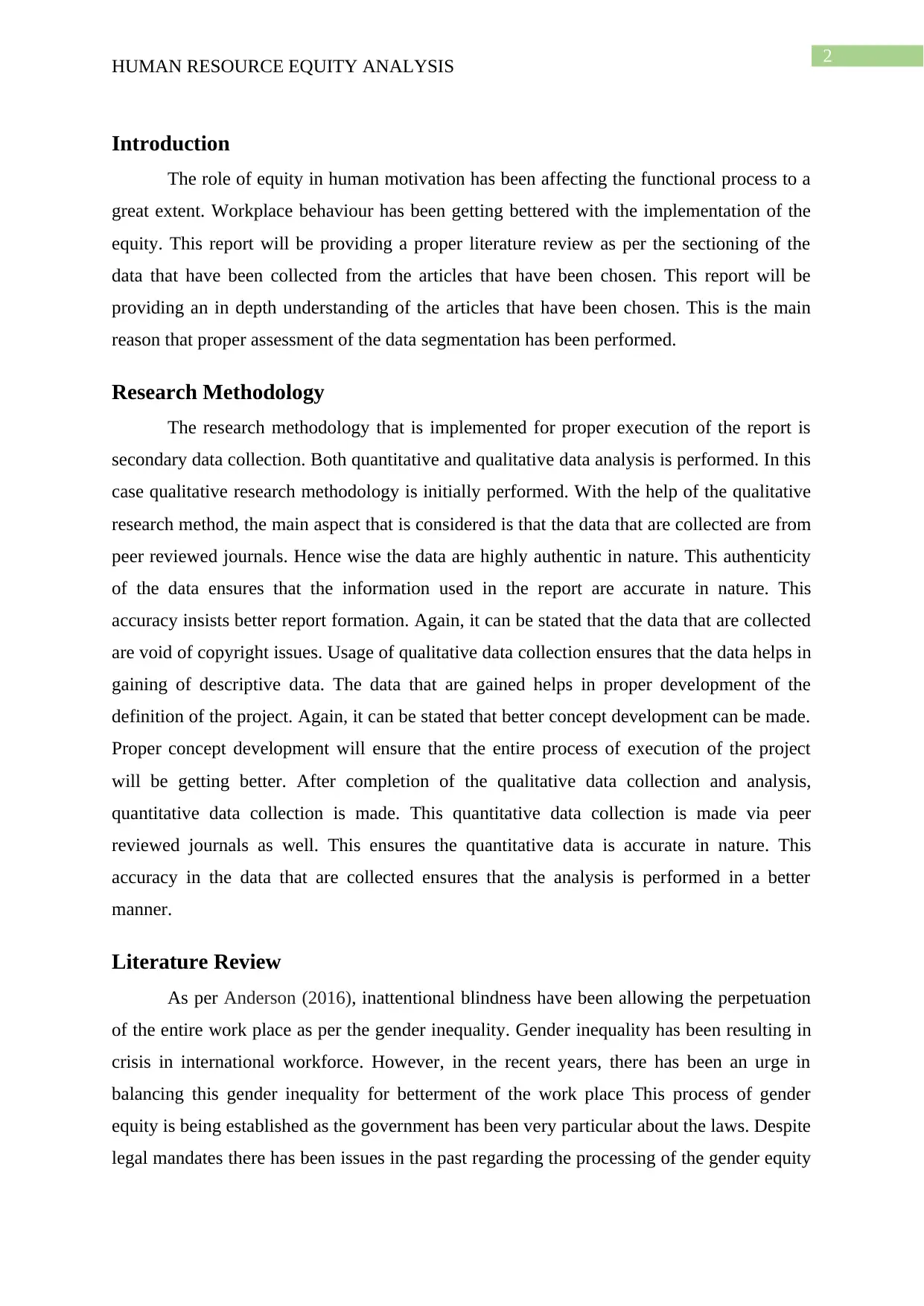
2
HUMAN RESOURCE EQUITY ANALYSIS
Introduction
The role of equity in human motivation has been affecting the functional process to a
great extent. Workplace behaviour has been getting bettered with the implementation of the
equity. This report will be providing a proper literature review as per the sectioning of the
data that have been collected from the articles that have been chosen. This report will be
providing an in depth understanding of the articles that have been chosen. This is the main
reason that proper assessment of the data segmentation has been performed.
Research Methodology
The research methodology that is implemented for proper execution of the report is
secondary data collection. Both quantitative and qualitative data analysis is performed. In this
case qualitative research methodology is initially performed. With the help of the qualitative
research method, the main aspect that is considered is that the data that are collected are from
peer reviewed journals. Hence wise the data are highly authentic in nature. This authenticity
of the data ensures that the information used in the report are accurate in nature. This
accuracy insists better report formation. Again, it can be stated that the data that are collected
are void of copyright issues. Usage of qualitative data collection ensures that the data helps in
gaining of descriptive data. The data that are gained helps in proper development of the
definition of the project. Again, it can be stated that better concept development can be made.
Proper concept development will ensure that the entire process of execution of the project
will be getting better. After completion of the qualitative data collection and analysis,
quantitative data collection is made. This quantitative data collection is made via peer
reviewed journals as well. This ensures the quantitative data is accurate in nature. This
accuracy in the data that are collected ensures that the analysis is performed in a better
manner.
Literature Review
As per Anderson (2016), inattentional blindness have been allowing the perpetuation
of the entire work place as per the gender inequality. Gender inequality has been resulting in
crisis in international workforce. However, in the recent years, there has been an urge in
balancing this gender inequality for betterment of the work place This process of gender
equity is being established as the government has been very particular about the laws. Despite
legal mandates there has been issues in the past regarding the processing of the gender equity
HUMAN RESOURCE EQUITY ANALYSIS
Introduction
The role of equity in human motivation has been affecting the functional process to a
great extent. Workplace behaviour has been getting bettered with the implementation of the
equity. This report will be providing a proper literature review as per the sectioning of the
data that have been collected from the articles that have been chosen. This report will be
providing an in depth understanding of the articles that have been chosen. This is the main
reason that proper assessment of the data segmentation has been performed.
Research Methodology
The research methodology that is implemented for proper execution of the report is
secondary data collection. Both quantitative and qualitative data analysis is performed. In this
case qualitative research methodology is initially performed. With the help of the qualitative
research method, the main aspect that is considered is that the data that are collected are from
peer reviewed journals. Hence wise the data are highly authentic in nature. This authenticity
of the data ensures that the information used in the report are accurate in nature. This
accuracy insists better report formation. Again, it can be stated that the data that are collected
are void of copyright issues. Usage of qualitative data collection ensures that the data helps in
gaining of descriptive data. The data that are gained helps in proper development of the
definition of the project. Again, it can be stated that better concept development can be made.
Proper concept development will ensure that the entire process of execution of the project
will be getting better. After completion of the qualitative data collection and analysis,
quantitative data collection is made. This quantitative data collection is made via peer
reviewed journals as well. This ensures the quantitative data is accurate in nature. This
accuracy in the data that are collected ensures that the analysis is performed in a better
manner.
Literature Review
As per Anderson (2016), inattentional blindness have been allowing the perpetuation
of the entire work place as per the gender inequality. Gender inequality has been resulting in
crisis in international workforce. However, in the recent years, there has been an urge in
balancing this gender inequality for betterment of the work place This process of gender
equity is being established as the government has been very particular about the laws. Despite
legal mandates there has been issues in the past regarding the processing of the gender equity
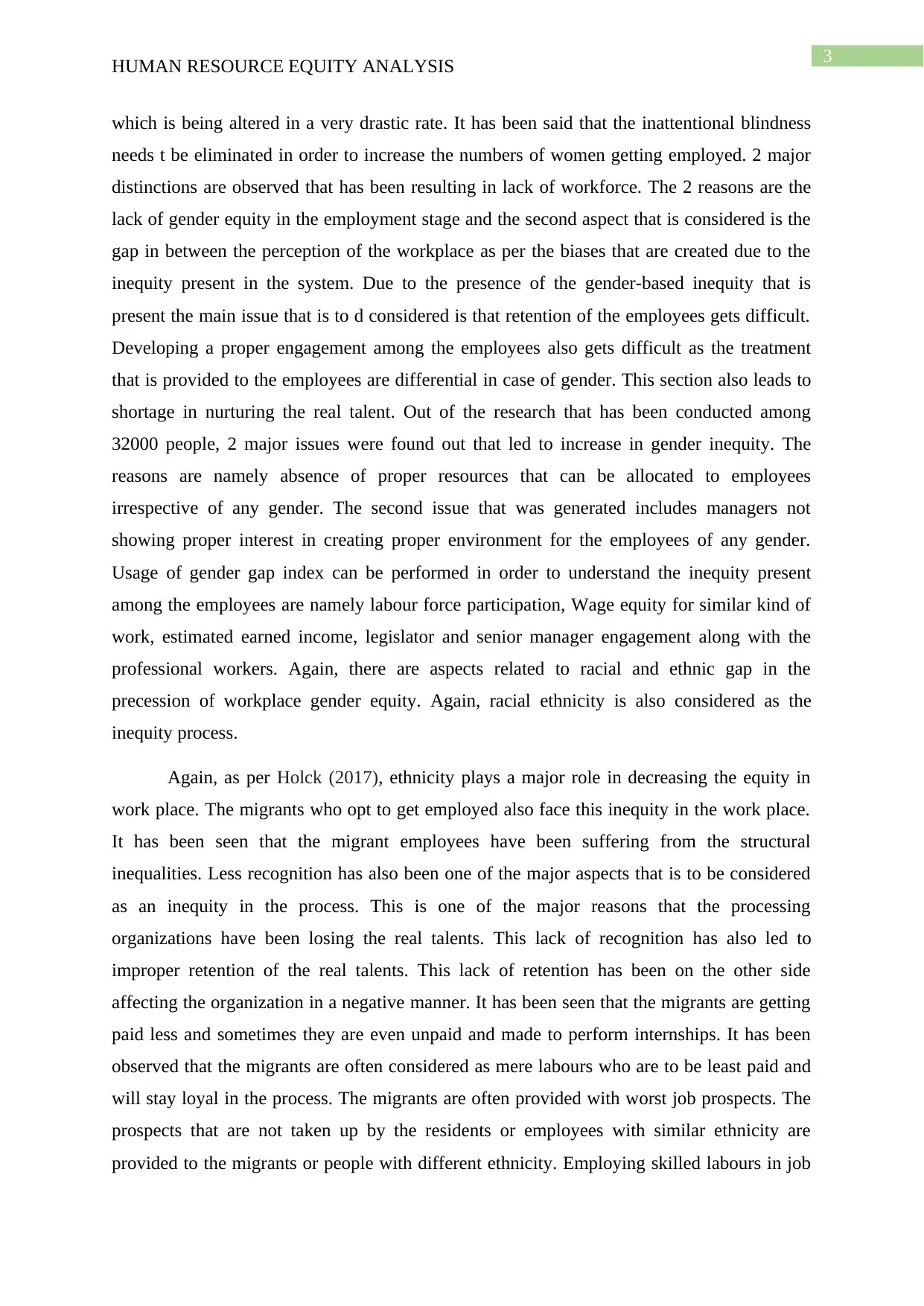
3
HUMAN RESOURCE EQUITY ANALYSIS
which is being altered in a very drastic rate. It has been said that the inattentional blindness
needs t be eliminated in order to increase the numbers of women getting employed. 2 major
distinctions are observed that has been resulting in lack of workforce. The 2 reasons are the
lack of gender equity in the employment stage and the second aspect that is considered is the
gap in between the perception of the workplace as per the biases that are created due to the
inequity present in the system. Due to the presence of the gender-based inequity that is
present the main issue that is to d considered is that retention of the employees gets difficult.
Developing a proper engagement among the employees also gets difficult as the treatment
that is provided to the employees are differential in case of gender. This section also leads to
shortage in nurturing the real talent. Out of the research that has been conducted among
32000 people, 2 major issues were found out that led to increase in gender inequity. The
reasons are namely absence of proper resources that can be allocated to employees
irrespective of any gender. The second issue that was generated includes managers not
showing proper interest in creating proper environment for the employees of any gender.
Usage of gender gap index can be performed in order to understand the inequity present
among the employees are namely labour force participation, Wage equity for similar kind of
work, estimated earned income, legislator and senior manager engagement along with the
professional workers. Again, there are aspects related to racial and ethnic gap in the
precession of workplace gender equity. Again, racial ethnicity is also considered as the
inequity process.
Again, as per Holck (2017), ethnicity plays a major role in decreasing the equity in
work place. The migrants who opt to get employed also face this inequity in the work place.
It has been seen that the migrant employees have been suffering from the structural
inequalities. Less recognition has also been one of the major aspects that is to be considered
as an inequity in the process. This is one of the major reasons that the processing
organizations have been losing the real talents. This lack of recognition has also led to
improper retention of the real talents. This lack of retention has been on the other side
affecting the organization in a negative manner. It has been seen that the migrants are getting
paid less and sometimes they are even unpaid and made to perform internships. It has been
observed that the migrants are often considered as mere labours who are to be least paid and
will stay loyal in the process. The migrants are often provided with worst job prospects. The
prospects that are not taken up by the residents or employees with similar ethnicity are
provided to the migrants or people with different ethnicity. Employing skilled labours in job
HUMAN RESOURCE EQUITY ANALYSIS
which is being altered in a very drastic rate. It has been said that the inattentional blindness
needs t be eliminated in order to increase the numbers of women getting employed. 2 major
distinctions are observed that has been resulting in lack of workforce. The 2 reasons are the
lack of gender equity in the employment stage and the second aspect that is considered is the
gap in between the perception of the workplace as per the biases that are created due to the
inequity present in the system. Due to the presence of the gender-based inequity that is
present the main issue that is to d considered is that retention of the employees gets difficult.
Developing a proper engagement among the employees also gets difficult as the treatment
that is provided to the employees are differential in case of gender. This section also leads to
shortage in nurturing the real talent. Out of the research that has been conducted among
32000 people, 2 major issues were found out that led to increase in gender inequity. The
reasons are namely absence of proper resources that can be allocated to employees
irrespective of any gender. The second issue that was generated includes managers not
showing proper interest in creating proper environment for the employees of any gender.
Usage of gender gap index can be performed in order to understand the inequity present
among the employees are namely labour force participation, Wage equity for similar kind of
work, estimated earned income, legislator and senior manager engagement along with the
professional workers. Again, there are aspects related to racial and ethnic gap in the
precession of workplace gender equity. Again, racial ethnicity is also considered as the
inequity process.
Again, as per Holck (2017), ethnicity plays a major role in decreasing the equity in
work place. The migrants who opt to get employed also face this inequity in the work place.
It has been seen that the migrant employees have been suffering from the structural
inequalities. Less recognition has also been one of the major aspects that is to be considered
as an inequity in the process. This is one of the major reasons that the processing
organizations have been losing the real talents. This lack of recognition has also led to
improper retention of the real talents. This lack of retention has been on the other side
affecting the organization in a negative manner. It has been seen that the migrants are getting
paid less and sometimes they are even unpaid and made to perform internships. It has been
observed that the migrants are often considered as mere labours who are to be least paid and
will stay loyal in the process. The migrants are often provided with worst job prospects. The
prospects that are not taken up by the residents or employees with similar ethnicity are
provided to the migrants or people with different ethnicity. Employing skilled labours in job
Secure Best Marks with AI Grader
Need help grading? Try our AI Grader for instant feedback on your assignments.
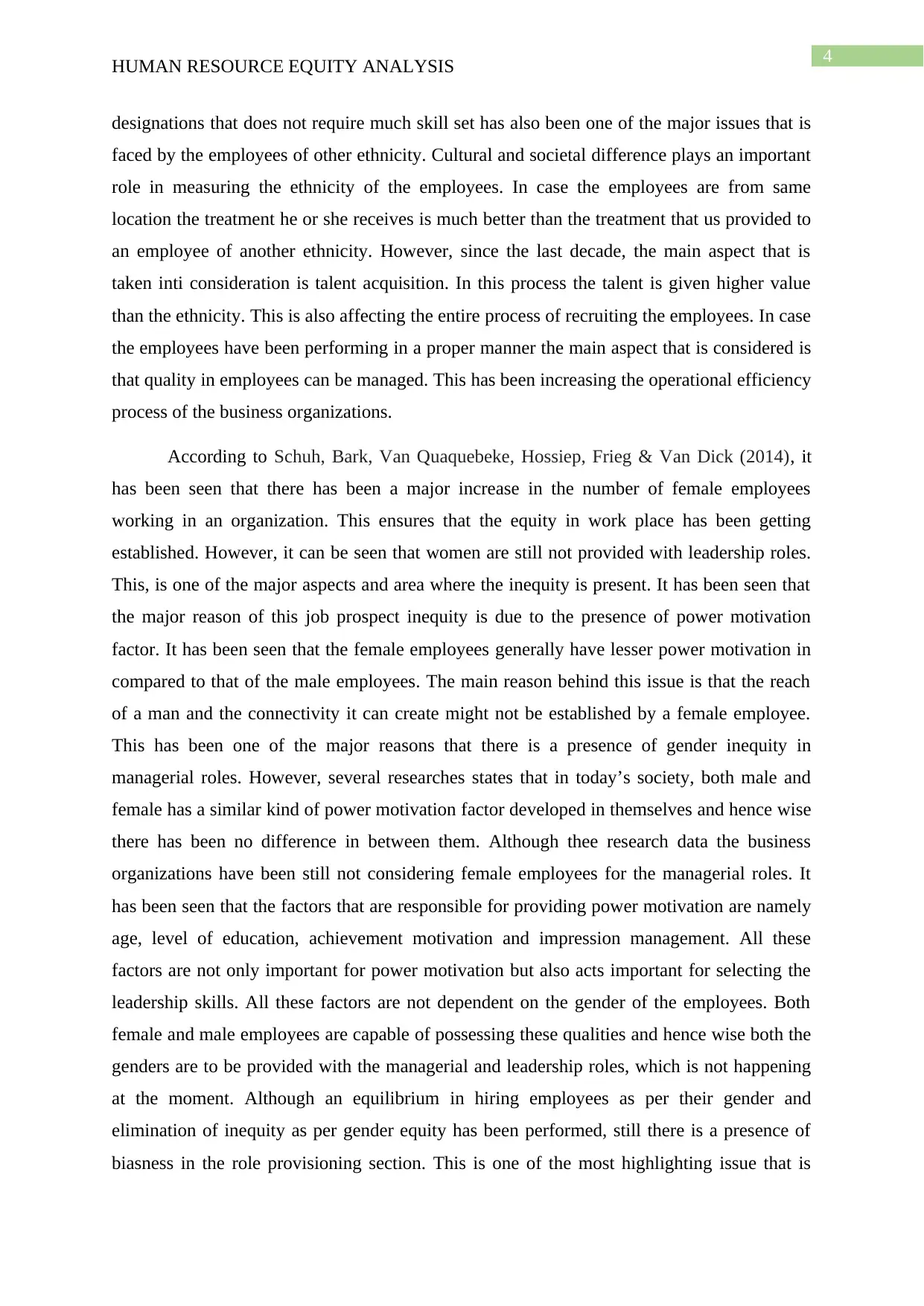
4
HUMAN RESOURCE EQUITY ANALYSIS
designations that does not require much skill set has also been one of the major issues that is
faced by the employees of other ethnicity. Cultural and societal difference plays an important
role in measuring the ethnicity of the employees. In case the employees are from same
location the treatment he or she receives is much better than the treatment that us provided to
an employee of another ethnicity. However, since the last decade, the main aspect that is
taken inti consideration is talent acquisition. In this process the talent is given higher value
than the ethnicity. This is also affecting the entire process of recruiting the employees. In case
the employees have been performing in a proper manner the main aspect that is considered is
that quality in employees can be managed. This has been increasing the operational efficiency
process of the business organizations.
According to Schuh, Bark, Van Quaquebeke, Hossiep, Frieg & Van Dick (2014), it
has been seen that there has been a major increase in the number of female employees
working in an organization. This ensures that the equity in work place has been getting
established. However, it can be seen that women are still not provided with leadership roles.
This, is one of the major aspects and area where the inequity is present. It has been seen that
the major reason of this job prospect inequity is due to the presence of power motivation
factor. It has been seen that the female employees generally have lesser power motivation in
compared to that of the male employees. The main reason behind this issue is that the reach
of a man and the connectivity it can create might not be established by a female employee.
This has been one of the major reasons that there is a presence of gender inequity in
managerial roles. However, several researches states that in today’s society, both male and
female has a similar kind of power motivation factor developed in themselves and hence wise
there has been no difference in between them. Although thee research data the business
organizations have been still not considering female employees for the managerial roles. It
has been seen that the factors that are responsible for providing power motivation are namely
age, level of education, achievement motivation and impression management. All these
factors are not only important for power motivation but also acts important for selecting the
leadership skills. All these factors are not dependent on the gender of the employees. Both
female and male employees are capable of possessing these qualities and hence wise both the
genders are to be provided with the managerial and leadership roles, which is not happening
at the moment. Although an equilibrium in hiring employees as per their gender and
elimination of inequity as per gender equity has been performed, still there is a presence of
biasness in the role provisioning section. This is one of the most highlighting issue that is
HUMAN RESOURCE EQUITY ANALYSIS
designations that does not require much skill set has also been one of the major issues that is
faced by the employees of other ethnicity. Cultural and societal difference plays an important
role in measuring the ethnicity of the employees. In case the employees are from same
location the treatment he or she receives is much better than the treatment that us provided to
an employee of another ethnicity. However, since the last decade, the main aspect that is
taken inti consideration is talent acquisition. In this process the talent is given higher value
than the ethnicity. This is also affecting the entire process of recruiting the employees. In case
the employees have been performing in a proper manner the main aspect that is considered is
that quality in employees can be managed. This has been increasing the operational efficiency
process of the business organizations.
According to Schuh, Bark, Van Quaquebeke, Hossiep, Frieg & Van Dick (2014), it
has been seen that there has been a major increase in the number of female employees
working in an organization. This ensures that the equity in work place has been getting
established. However, it can be seen that women are still not provided with leadership roles.
This, is one of the major aspects and area where the inequity is present. It has been seen that
the major reason of this job prospect inequity is due to the presence of power motivation
factor. It has been seen that the female employees generally have lesser power motivation in
compared to that of the male employees. The main reason behind this issue is that the reach
of a man and the connectivity it can create might not be established by a female employee.
This has been one of the major reasons that there is a presence of gender inequity in
managerial roles. However, several researches states that in today’s society, both male and
female has a similar kind of power motivation factor developed in themselves and hence wise
there has been no difference in between them. Although thee research data the business
organizations have been still not considering female employees for the managerial roles. It
has been seen that the factors that are responsible for providing power motivation are namely
age, level of education, achievement motivation and impression management. All these
factors are not only important for power motivation but also acts important for selecting the
leadership skills. All these factors are not dependent on the gender of the employees. Both
female and male employees are capable of possessing these qualities and hence wise both the
genders are to be provided with the managerial and leadership roles, which is not happening
at the moment. Although an equilibrium in hiring employees as per their gender and
elimination of inequity as per gender equity has been performed, still there is a presence of
biasness in the role provisioning section. This is one of the most highlighting issue that is
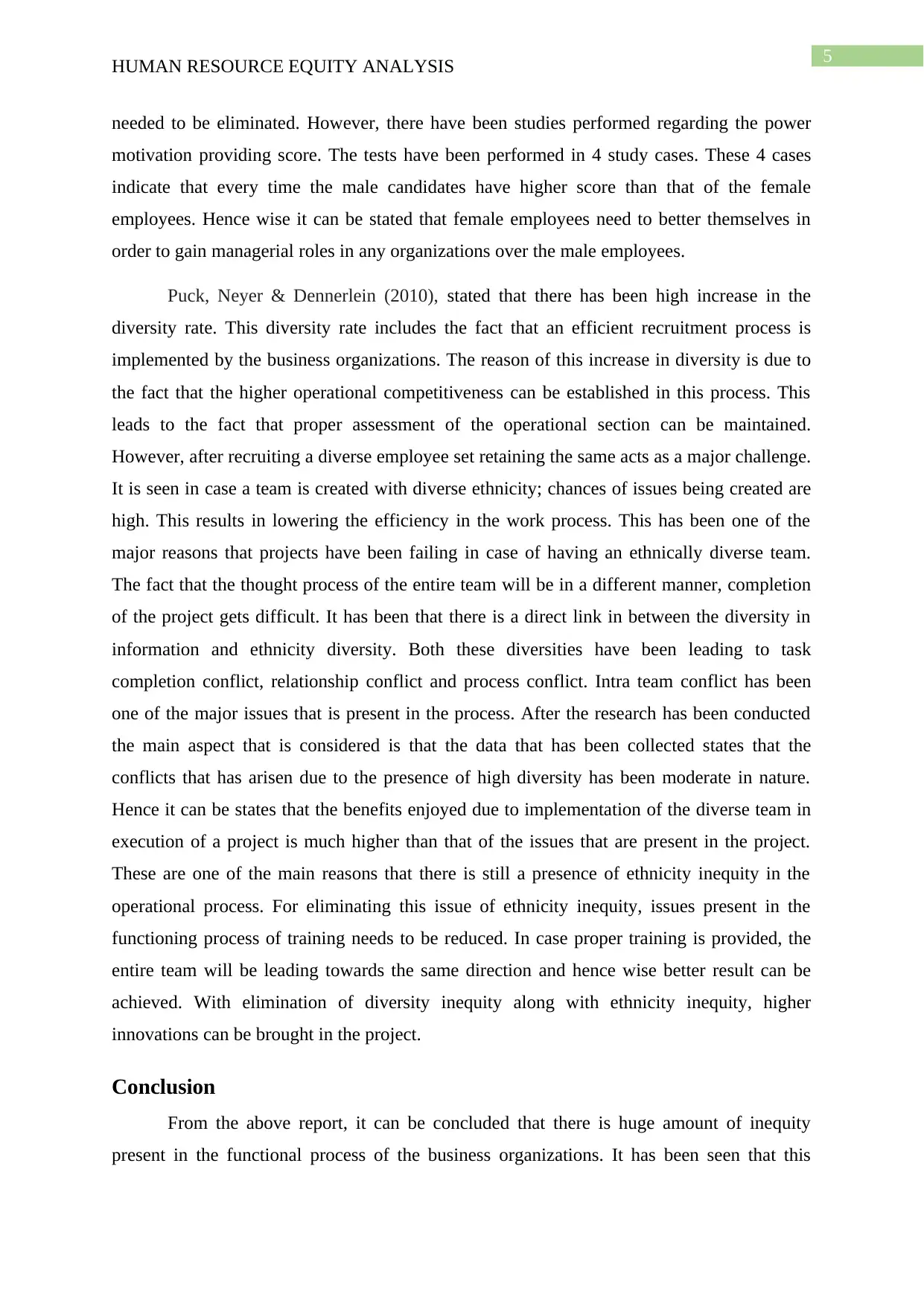
5
HUMAN RESOURCE EQUITY ANALYSIS
needed to be eliminated. However, there have been studies performed regarding the power
motivation providing score. The tests have been performed in 4 study cases. These 4 cases
indicate that every time the male candidates have higher score than that of the female
employees. Hence wise it can be stated that female employees need to better themselves in
order to gain managerial roles in any organizations over the male employees.
Puck, Neyer & Dennerlein (2010), stated that there has been high increase in the
diversity rate. This diversity rate includes the fact that an efficient recruitment process is
implemented by the business organizations. The reason of this increase in diversity is due to
the fact that the higher operational competitiveness can be established in this process. This
leads to the fact that proper assessment of the operational section can be maintained.
However, after recruiting a diverse employee set retaining the same acts as a major challenge.
It is seen in case a team is created with diverse ethnicity; chances of issues being created are
high. This results in lowering the efficiency in the work process. This has been one of the
major reasons that projects have been failing in case of having an ethnically diverse team.
The fact that the thought process of the entire team will be in a different manner, completion
of the project gets difficult. It has been that there is a direct link in between the diversity in
information and ethnicity diversity. Both these diversities have been leading to task
completion conflict, relationship conflict and process conflict. Intra team conflict has been
one of the major issues that is present in the process. After the research has been conducted
the main aspect that is considered is that the data that has been collected states that the
conflicts that has arisen due to the presence of high diversity has been moderate in nature.
Hence it can be states that the benefits enjoyed due to implementation of the diverse team in
execution of a project is much higher than that of the issues that are present in the project.
These are one of the main reasons that there is still a presence of ethnicity inequity in the
operational process. For eliminating this issue of ethnicity inequity, issues present in the
functioning process of training needs to be reduced. In case proper training is provided, the
entire team will be leading towards the same direction and hence wise better result can be
achieved. With elimination of diversity inequity along with ethnicity inequity, higher
innovations can be brought in the project.
Conclusion
From the above report, it can be concluded that there is huge amount of inequity
present in the functional process of the business organizations. It has been seen that this
HUMAN RESOURCE EQUITY ANALYSIS
needed to be eliminated. However, there have been studies performed regarding the power
motivation providing score. The tests have been performed in 4 study cases. These 4 cases
indicate that every time the male candidates have higher score than that of the female
employees. Hence wise it can be stated that female employees need to better themselves in
order to gain managerial roles in any organizations over the male employees.
Puck, Neyer & Dennerlein (2010), stated that there has been high increase in the
diversity rate. This diversity rate includes the fact that an efficient recruitment process is
implemented by the business organizations. The reason of this increase in diversity is due to
the fact that the higher operational competitiveness can be established in this process. This
leads to the fact that proper assessment of the operational section can be maintained.
However, after recruiting a diverse employee set retaining the same acts as a major challenge.
It is seen in case a team is created with diverse ethnicity; chances of issues being created are
high. This results in lowering the efficiency in the work process. This has been one of the
major reasons that projects have been failing in case of having an ethnically diverse team.
The fact that the thought process of the entire team will be in a different manner, completion
of the project gets difficult. It has been that there is a direct link in between the diversity in
information and ethnicity diversity. Both these diversities have been leading to task
completion conflict, relationship conflict and process conflict. Intra team conflict has been
one of the major issues that is present in the process. After the research has been conducted
the main aspect that is considered is that the data that has been collected states that the
conflicts that has arisen due to the presence of high diversity has been moderate in nature.
Hence it can be states that the benefits enjoyed due to implementation of the diverse team in
execution of a project is much higher than that of the issues that are present in the project.
These are one of the main reasons that there is still a presence of ethnicity inequity in the
operational process. For eliminating this issue of ethnicity inequity, issues present in the
functioning process of training needs to be reduced. In case proper training is provided, the
entire team will be leading towards the same direction and hence wise better result can be
achieved. With elimination of diversity inequity along with ethnicity inequity, higher
innovations can be brought in the project.
Conclusion
From the above report, it can be concluded that there is huge amount of inequity
present in the functional process of the business organizations. It has been seen that this
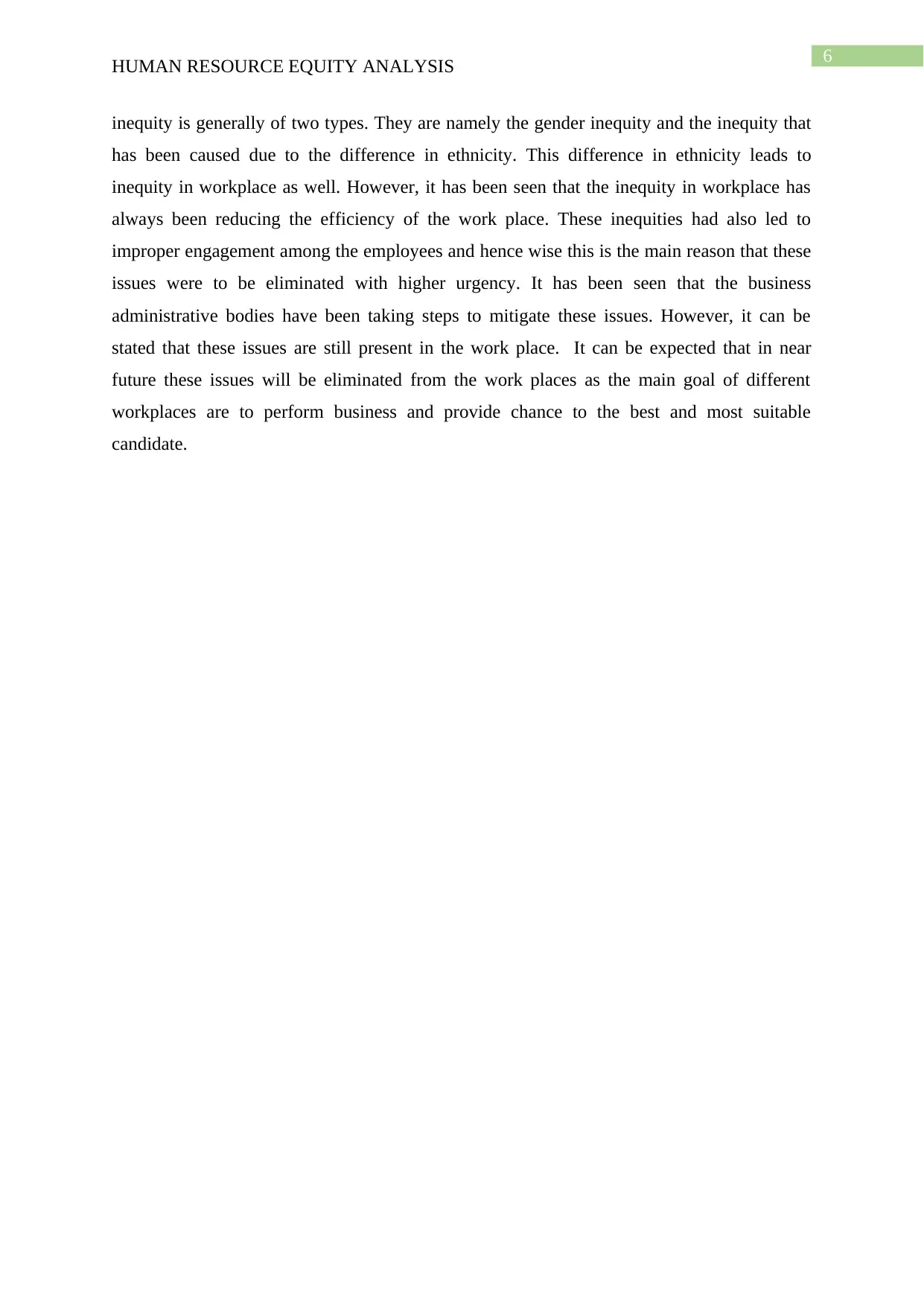
6
HUMAN RESOURCE EQUITY ANALYSIS
inequity is generally of two types. They are namely the gender inequity and the inequity that
has been caused due to the difference in ethnicity. This difference in ethnicity leads to
inequity in workplace as well. However, it has been seen that the inequity in workplace has
always been reducing the efficiency of the work place. These inequities had also led to
improper engagement among the employees and hence wise this is the main reason that these
issues were to be eliminated with higher urgency. It has been seen that the business
administrative bodies have been taking steps to mitigate these issues. However, it can be
stated that these issues are still present in the work place. It can be expected that in near
future these issues will be eliminated from the work places as the main goal of different
workplaces are to perform business and provide chance to the best and most suitable
candidate.
HUMAN RESOURCE EQUITY ANALYSIS
inequity is generally of two types. They are namely the gender inequity and the inequity that
has been caused due to the difference in ethnicity. This difference in ethnicity leads to
inequity in workplace as well. However, it has been seen that the inequity in workplace has
always been reducing the efficiency of the work place. These inequities had also led to
improper engagement among the employees and hence wise this is the main reason that these
issues were to be eliminated with higher urgency. It has been seen that the business
administrative bodies have been taking steps to mitigate these issues. However, it can be
stated that these issues are still present in the work place. It can be expected that in near
future these issues will be eliminated from the work places as the main goal of different
workplaces are to perform business and provide chance to the best and most suitable
candidate.
Paraphrase This Document
Need a fresh take? Get an instant paraphrase of this document with our AI Paraphraser
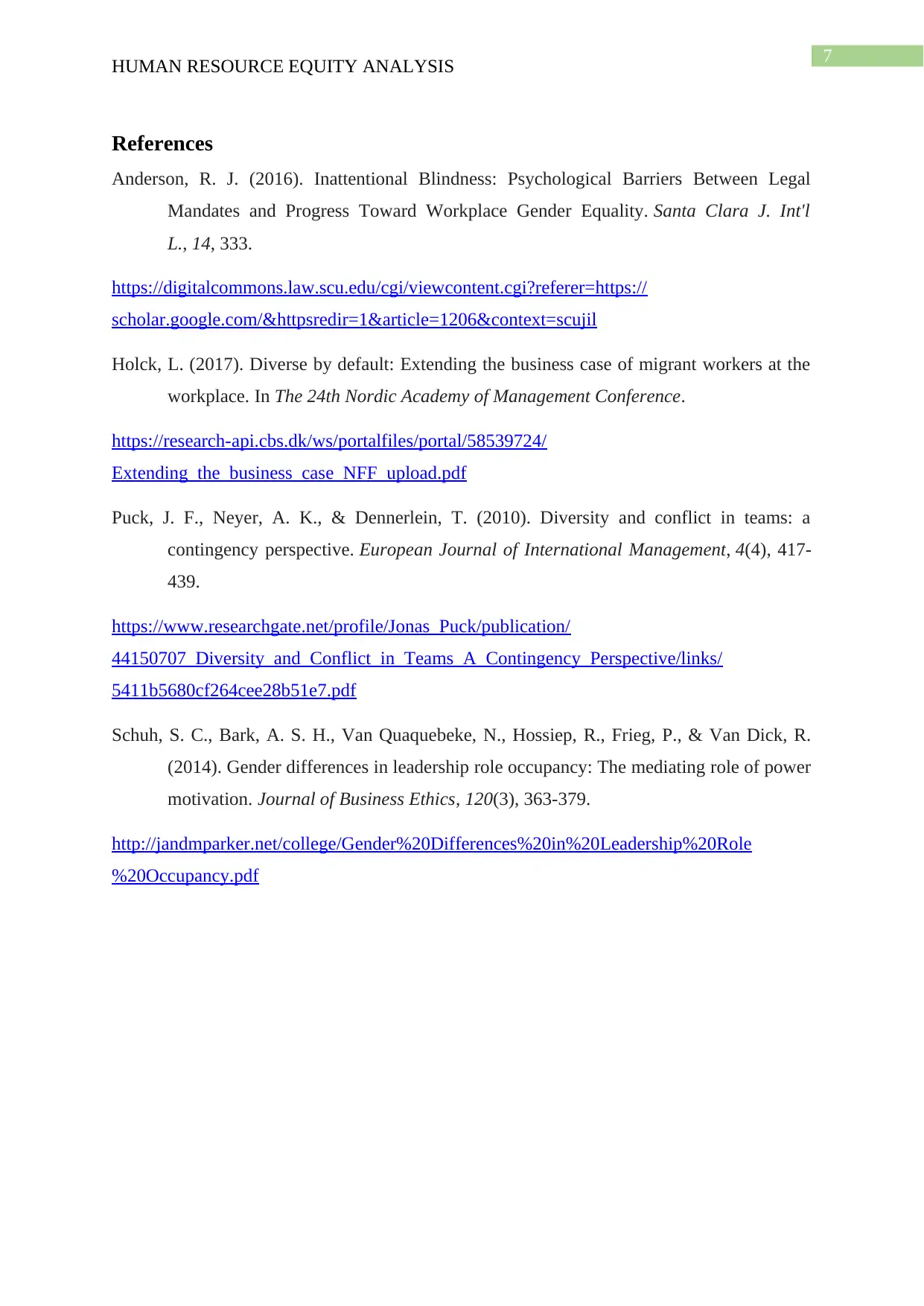
7
HUMAN RESOURCE EQUITY ANALYSIS
References
Anderson, R. J. (2016). Inattentional Blindness: Psychological Barriers Between Legal
Mandates and Progress Toward Workplace Gender Equality. Santa Clara J. Int'l
L., 14, 333.
https://digitalcommons.law.scu.edu/cgi/viewcontent.cgi?referer=https://
scholar.google.com/&httpsredir=1&article=1206&context=scujil
Holck, L. (2017). Diverse by default: Extending the business case of migrant workers at the
workplace. In The 24th Nordic Academy of Management Conference.
https://research-api.cbs.dk/ws/portalfiles/portal/58539724/
Extending_the_business_case_NFF_upload.pdf
Puck, J. F., Neyer, A. K., & Dennerlein, T. (2010). Diversity and conflict in teams: a
contingency perspective. European Journal of International Management, 4(4), 417-
439.
https://www.researchgate.net/profile/Jonas_Puck/publication/
44150707_Diversity_and_Conflict_in_Teams_A_Contingency_Perspective/links/
5411b5680cf264cee28b51e7.pdf
Schuh, S. C., Bark, A. S. H., Van Quaquebeke, N., Hossiep, R., Frieg, P., & Van Dick, R.
(2014). Gender differences in leadership role occupancy: The mediating role of power
motivation. Journal of Business Ethics, 120(3), 363-379.
http://jandmparker.net/college/Gender%20Differences%20in%20Leadership%20Role
%20Occupancy.pdf
HUMAN RESOURCE EQUITY ANALYSIS
References
Anderson, R. J. (2016). Inattentional Blindness: Psychological Barriers Between Legal
Mandates and Progress Toward Workplace Gender Equality. Santa Clara J. Int'l
L., 14, 333.
https://digitalcommons.law.scu.edu/cgi/viewcontent.cgi?referer=https://
scholar.google.com/&httpsredir=1&article=1206&context=scujil
Holck, L. (2017). Diverse by default: Extending the business case of migrant workers at the
workplace. In The 24th Nordic Academy of Management Conference.
https://research-api.cbs.dk/ws/portalfiles/portal/58539724/
Extending_the_business_case_NFF_upload.pdf
Puck, J. F., Neyer, A. K., & Dennerlein, T. (2010). Diversity and conflict in teams: a
contingency perspective. European Journal of International Management, 4(4), 417-
439.
https://www.researchgate.net/profile/Jonas_Puck/publication/
44150707_Diversity_and_Conflict_in_Teams_A_Contingency_Perspective/links/
5411b5680cf264cee28b51e7.pdf
Schuh, S. C., Bark, A. S. H., Van Quaquebeke, N., Hossiep, R., Frieg, P., & Van Dick, R.
(2014). Gender differences in leadership role occupancy: The mediating role of power
motivation. Journal of Business Ethics, 120(3), 363-379.
http://jandmparker.net/college/Gender%20Differences%20in%20Leadership%20Role
%20Occupancy.pdf
1 out of 8
Related Documents
Your All-in-One AI-Powered Toolkit for Academic Success.
+13062052269
info@desklib.com
Available 24*7 on WhatsApp / Email
![[object Object]](/_next/static/media/star-bottom.7253800d.svg)
Unlock your academic potential
© 2024 | Zucol Services PVT LTD | All rights reserved.





